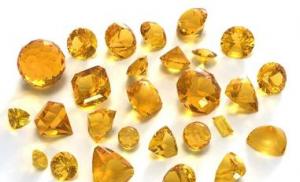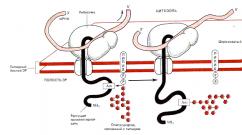How many calories are in stewed cabbage, why nutritionists recommend it. How many calories are in stewed cabbage
You can seriously discuss the calorie content of stewed cabbage only if you stewed it yourself. Or watched the process, recording and weighing. On the Internet, on a site focused on tasty, but not healthy food, you can find two dozen recipes for this cabbage of varying calorie content. Someone first fries vegetables with onions on vegetable oil, without measuring it, but simply pouring it into the pan. Someone does the same thing, but with butter. Others do not use oil, but fill the cabbage with a mixture of tomato paste and flour with sour cream. In general, as many people as there are, so many opinions. The calorie content of the standard “canteen” version of this dish is 122 kcal per 100 g, mainly from fats and carbohydrates. "Lite" options may vary. It also makes no sense to memorize any single table value. Nowhere is it disclosed exactly how much of the notorious oil and flour was added to the “tabular” cabbage. However, some versions of this dish are considered terribly healthy.
The content of the article:
If you take the “Healthy Lifestyle Recipe”, in which shredded cabbage and 1 onion are first simmered in water, and then a spoonful of sugar-free tomato paste is added, and everything is stewed until tender - this is a very healthy dish. First of all, the volume of vegetables is large, and the caloric output is no more than 40 kcal per 100 g. This is so low because no oil is added during cooking. This is the main complaint about this recipe. For many people, this cabbage resembles the notorious Bonn soup. It seems that the soup is healthy, and it’s hot... but you don’t get enough of it, and that’s all.

However, these are the vegetables that are recommended to be eaten by those who want to lose weight through a diet. Most often, such a dish appears in a simple “fist, fist and palm” layout. That is, a fist-sized portion of vegetables (in this case, cabbage), an equal-sized portion of grains, and a palm-sized portion of protein sources. Cabbage is one of the cheapest vegetables and its consumption contributes not only to health, but also to significant savings.
The fiber in cabbage can:
- increase the volume of the food bolus and save a person from the eternal pangs of hunger that haunt everyone who suddenly decides to lose weight through a diet;
- eradicate digestive problems and help relieve constipation. By the way, it is cabbage that is recommended to supporters protein diets in order not to suffer from constipation and not to experience too slow digestion;
- slightly slow down the absorption of simple carbohydrates. So stewed cabbage is good for everyone who strives, for example, to eat more apples as part of their low calorie diet.
Fiber can, of course, be eaten fresh, but frankly speaking, we don’t have many dishes that contain few calories and a lot of fiber and are hot and familiar at the same time.
One small problem - stewed cabbage is often touted as a source of vitamins and minerals. But it all depends on the cooking time. However, water-soluble vitamins are sometimes lost and many people experience problems with vitamin deficiency when switching to “only cooked” foods. For the most part, stewed cabbage only contributes to a healthier diet when it is properly prepared.
It is often said that stewed cabbage is the best choice for a person who has forgotten his lunch at home and wants to try catering food. Actually In fact, this is not always fair.

In general, strict supporters of a healthy lifestyle classify everything that is not prepared independently into the broad category of “harmful and questionable food.” A public catering dish called “stewed cabbage” is usually not good. And they buy it only because it is cheap and in the belief that cabbage is still better than potatoes or overcooked pasta.
By and large, the “very bad” things about it are:
- some chefs actually left the USSR along with their kitchen utensils. A cast-iron blackened frying pan on which olija is sizzling - dark sunflower oil with smell, bowls of chopped onions and shredded cabbage, flour with tomato paste under the “cheapest” brand. This is not the author’s imagination, but a completely normal process of preparing cabbage from a technological point of view. Yes, first it is fried in oil along with onions. It turns out “vegetables plus 200 kcal, on average.” Then it is poured with a “mash” of tomato paste, flour and water. In some cases, add a little more oil. The product is stewed, and there is no expectation that it is a healthy product. The culprit is pre-frying. Who knows what kind of catering you will come across, but legends about “machine oil” in which pies are first fried, then - potatoes, and then - whites, let's say, are not always legends, but sometimes such a semi-legal way to save money and steal more oil home. So carcinogenic oil, overcooked a hundred times, may very well be found in your cabbage. How to distinguish such a dish? The vegetables will be darkened, almost brown, interspersed with onions that have been fried too much.
Another harmful dish is homemade cabbage from the “what was in the refrigerator, that’s what I put in” series. Usually, for some reason, sausage is cut into such cabbage, and often smoked (some comrades believe that this is how we get a dish of German cuisine. In fact, from vegetables we get a thermonuclear mixture with artificial liquid smoke, a bunch of superheated oil and fats of unknown origin from sausage. And this, in fact, does not add protein. Usually half a jar of mayonnaise or some kind of 1000 islands sauce is poured into it and the result is something indigestible
So, food that even remotely fits this exaggerated description is harmful. It causes the liver to work harder, and the gallbladder to literally overflow with bile. Regular consumption of such wonderful foods and dishes can cause pancreatitis in even a relatively healthy person. Such vegetables are also of no use to digestion, so if you really want fatty junk food, you don’t have to torture yourself by frying vegetables and then stewing them. A sandwich with sausage and mayonnaise will do all the work for you.

So, cabbage is harmful if it is too full of excess fats and seasoned with flour dressing. But there is one more product, so to speak, of home cooking. This is cabbage cooked in water and a small amount of vegetable oil. But initially - not just ordinary cabbage, but the most salted or pickled cabbage. A large amount of salt is far from decorating a “traditional recipe” with a lot of vegetable oil. Such dishes in the diet can provoke an increase in blood pressure and seriously worsen cardiovascular health.
Different sources give different figures - from 36 kcal to 181, this is if with smoked sausage. It is completely unrealistic to calculate the BJU. But the vast majority of healthy eating guides will indicate that stewed cabbage is a source of potassium, calcium, magnesium, iron, vitamins C, E, A, B1, PP and the healthiest product. Here, as they say, trust, but verify.
Approximate calorie content of dishes with stewed cabbage:
- with chicken – 154.84 kcal;
- with beef – 158.52 kcal;
- with pork – 144.53 kcal;
- with mushrooms – 119.79 kcal;
- with carrots – 40.00 kcal;
- with potatoes – 124.99 kcal;
- with ginger – 36.76 kcal;
- in tomato – 99.30 kcal;
A person who does not care about his own appearance is unlikely to understand someone who is constantly on diets. It is unlikely that he will be able to understand why it is worth regularly counting calories, denying himself many gastronomic pleasures for the sake of a beautiful body and a healthy spirit in it. Therefore, this article is just for those who dream of eating deliciously and not gaining weight, and we will talk about such a dish as stewed cabbage. What is the calorie content of stewed cabbage and what does it depend on?
Let's start with the fact that there are quite a few varieties of cabbage. This includes regular cabbage, cauliflower, Brussels sprouts, Peking sprouts, Savoy sprouts, broccoli, kohlrabi and other varieties. And, in order to know exactly the calorie content of stewed cabbage, it is important to take into account what variety of this vegetable crop the dish was prepared from. Moreover, it affects the final calorie content of the dish and the method of its preparation.
It is worth saying that the one that contains the maximum amount of vitamins and minerals is recognized as the most beneficial for the human body. This variety of cabbage, the most common in our latitudes, is especially rich in vitamin C, which it contains more than all known fruits, including even lemon. Therefore, strengthening your immune system and fighting infections is much healthier and more enjoyable with cabbage than with lemon. It is not for nothing that this variety of cabbage is the most common and most used for food.
Fans of low-calorie nutritious dishes will be pleased to know that this product can be consumed during diets, and at the same time, in any quantity. If fresh white cabbage has an energy value of 29 kilocalories, cauliflower – 32 kcal/100g. product, and Brussels sprouts – 44 kcal/100g. product, then the calorie content of stewed cabbage is 100 kilocalories per 100 grams of this dish. The increase in calorie content occurs due to the fact that fats are used during the cooking process, which increase the calorie content of the dish by almost 3 times.
But the benefits of cabbage are not only in its low calorie content. The invaluable effect that this product has on our body helps burn fat, cleanse the body, eliminate constipation and improve intestinal function. Add also the fact that, given the insignificant calorie content, cabbage has enormous nutritional value, because the same 100 grams of product account for 4.5 grams of carbohydrates and 2.5 grams of protein, and there are no fats.
But everyone understands that you won’t be satisfied with cabbage alone; a person needs to eat well, because this is the main rule of dietary nutrition. In this case, I wonder what the calorie content of stewed cabbage with meat is. It also all depends on the type of meat that is used in a particular dish. So, the energy value of cabbage with chicken will be 171 kcal/100g. product, pork with sauerkraut will give you 449 kilocalories per 100 grams of the dish. Therefore, having decided to diversify the cabbage with meat, the best option would still be chicken.
In addition to stewing, cabbage can also be fried or fermented. For your information, sauerkraut retains much more beneficial substances. Moreover, during the fermentation process, vitamin K is produced in it, an important element responsible for blood clotting. Vitamins C and B, of which there are also a lot in it, perfectly strengthen the immune system and nervous system. It is also interesting that the calorie content is the lowest among possible cabbage dishes, equal to 14 kcal.
As for fried cabbage, you should avoid oil when frying, since in this case it will lose fat, and the oil that enters the body clogs the blood vessels, since cholesterol is formed during this process. The energy value of this cabbage dish is 60 calories per 100 grams.
There are also contraindications for cabbage dishes. They apply to people who have diseases of the gastrointestinal tract, people with kidney disease, and people with diabetes. In other cases, you have an excellent opportunity to include sauerkraut, fried or stewed cabbage in your diet, enjoying its taste, getting full of it, and at the same time, without gaining a single extra kilogram. Learn to eat right!
The basis of many diets is cabbage. At the same time, stewing is considered the most diverse and simplest way to prepare it, since this preserves its dietary properties and vitamins. Stewed cabbage has minimal calorie content, and therefore it can be safely included in the menu when losing weight. In addition, the dish helps improve the metabolic process and warns against vascular diseases. The unique product contains folic acid, calcium, potassium, glucose, vitamins PP and B. The composition of the beautiful white cabbage has a beneficial effect on the functioning of the kidneys, heart and blood vessels, and also stimulates the synthesis of bile.
Vegetable calorie content
Stewed cabbage contains more calories than fresh cabbage, except for the one that is stewed in water. The exact figure can be derived if you know the recipe. As a rule, during the creation of a dish, vegetable oil, onions, mushrooms and other products are added. White cabbage perfectly satisfies hunger and does not provoke heaviness in the stomach. To ensure complete nutrition, on the advice of nutritionists, you should not limit yourself to such food for more than a week.
The Beijing variety is considered the lowest in calories, and therefore it is often added to salads, sandwiches and baked goods. You can also stew other types: kohlrabi, cauliflower, broccoli and Brussels sprouts.
Calorie counting of stewed cabbage
 Before preparing a dish, you need to take each component separately and calculate how many kcal it contains separately.
Before preparing a dish, you need to take each component separately and calculate how many kcal it contains separately.
Let's give an example: you take carrots (150 grams). According to the table with the energy value of products, it is clear that 100 g of vegetables contains 33 kilocalories. Then in 150 g there will be 49.5 (150 * 33/100).
After a similar manipulation has been carried out with each ingredient, it will be possible see total calories. To find out the weight of the finished dish, you should weigh the container separately, and at the end of cooking, simply subtract its weight. The total calories are then divided by the weight of the dish to get the calories per gram.
Important to remember! Even though water has no calories, it still counts when calculating your total weight. If you calculate the calorie content of a familiar recipe once, then you won’t need to do it all the time. Those who don’t have time to sit over calculations can use general calorie indicators:
- cabbage stewed with carrots – 40;
- dish with mushrooms – 112;
- product with tomato paste or tomatoes – 99;
- stewed cabbage with potatoes and onions – 124;
- cabbage without other vegetables with vegetable oil – 50;
- product without any additives – 40.
Taking into account the calorie content of stewed cabbage with vegetables, they note that the dish is truly dietary. The minimum energy value is noted in the dish without any additives, including oil only in water, but its taste quickly becomes boring.
Is it allowed to add meat to stewed cabbage?
 After solving the issue with the nutritional value of the dishes, it remains to clarify how many kcal there will be in such a dish? In fact, the fat content of stewed cabbage with meat will increase the calorie content. However, during cooking it is necessary that the cabbage takes up more space in the pan.
After solving the issue with the nutritional value of the dishes, it remains to clarify how many kcal there will be in such a dish? In fact, the fat content of stewed cabbage with meat will increase the calorie content. However, during cooking it is necessary that the cabbage takes up more space in the pan.
In this case The calorie content of the dish will be:
- 102 kcal when adding minced chicken;
- 150-155 – if you stew vegetables with chicken;
- 145 kcal – if you cook vegetables with pork;
- 160 is provided by beef.
Cooking a dish with pork requires maximum removal of the fat layer.
What are the benefits of stewed cabbage?
It has long been considered a vegetable of beauty, and therefore masks were made from it for beautiful skin. Eating cooked white cabbage is no less beneficial: it is enriched with vitamins B2 (supports energy exchange and skin elasticity) and PP (strengthens the wall of blood vessels). In addition, 200 g of vegetables contains ascorbic acid in the amount of the daily requirement. It has a positive effect on intestinal motility, and undigested fiber particles help cleanse the intestines.
Diet based on stewed cabbage
Nutritionists highlight a seven-day effective diet based on the consumption of this dish. The power supply is as follows:

This diet allows you to lose up to three extra pounds without fasting or special restrictions.
Contraindications
We must not forget that the vegetable also has its negative sides. It increases acidity, and therefore the vegetable prohibited for gastritis with high acidity. For the same reason, cabbage should not be included in the diet of patients with ulcers, diabetes mellitus and impaired renal function. Pregnancy is a contraindication for use. Bodybuilders and fitness enthusiasts should limit the vegetable when gaining weight, as it increases intestinal motility and reduces protein absorption.
As soon as you ask yourself the question: “How many calories are in stewed cabbage?”, be sure to remember that there are close to 100 types of this vegetable in the world. And there are no less recipes for its preparation, for which culinary experts have dubbed cabbage the “queen of vegetables.” And nutritionists support them. True, for a different reason. Cabbage is rich in fiber and vitamins, it is a natural antioxidant, and it is also low in calories. But not in any form.
But only fresh, regardless of the variety. Its calorie content varies from approximately 16 to 42 kcal per 100 g. Calorie content of the most popular types:
- Brussels sprouts – 33.5 kcal;
- broccoli – 34 kcal;
- cauliflower – 28.4 kcal;
- – 27 kcal;
- kohlrabi cabbage – 42 kcal;
- – 16 kcal;
- red cabbage – 24.1 kcal;
- savoy cabbage – 28.2 kcal;
- – 24.9 kcal.
So what's the deal with stewed cabbage? This is a complete independent dish. Therefore, everything here depends not so much on the type and variety of cabbage, but on the components of the dish. After all, not only water and cabbage are used for cooking. You can add anything you like here: fried onions and carrots, meat, broth, spices, etc. The calorie content of vegetables increases due to oil and frying. Meat, as a rule, contains fats, which also increase the energy value of the dish. As a result, the calorie content of fresh cabbage increases by an average of 3 times.
How to calculate the calorie content of stewed cabbage?
- To do this, weigh each ingredient separately and calculate its calorie content using the table. For example, for cooking you need 150 g of carrots. According to the table, the energy value of 100 g of carrots is 33 kcal. Then for 150 g it will be: (150*33)/100 = 49.5 kcal.
- Now add up the calories of all components and get the total calories.
- Separately weigh the container in which the dish is being prepared.
- Weigh the finished dish and subtract the weight of the utensil. This way you will know the weight of the finished dish.
- All that remains is to divide the total calorie content by the total weight of the finished dish, and you will get the calorie content per 1 gram. To find out the energy value of 100 g of stewed cabbage, multiply this number by 100. If you want to find out the calorie content of one serving of a dish, divide the total calorie content by the number of servings.
Important! Despite the fact that the calorie content of water is zero, be sure to take it into account when calculating your total weight.
Having once calculated the calorie content of stewed cabbage according to the usual recipe, you do not need to do it again every time after the next preparation. The final figure will change slightly even if you do not strictly follow the recipe.
For those who don’t have time to count the calorie content of stewed cabbage, the table shows the average indicators for ready-made dishes.
| Name | Calorie content per 100 g, kcal |
| Stewed cabbage with chicken | 154,84 |
| Stewed cabbage with beef | 158,52 |
| Stewed cabbage with pork | 144,53 |
| Stewed cabbage with mushrooms | 119,79 |
| Stewed cabbage with carrots | 40,00 |
| Stewed cabbage with potatoes | 124,99 |
| Stewed Chinese cabbage with ginger | 36,76 |
| Stewed cabbage in tomato | 99,30 |
| Stewed cabbage with oyster mushrooms | 61,15 |
| Stewed cabbage with minced chicken | 102,20 |
- Fry the onion with grated carrots until golden brown.
- Boil the chicken fillet separately. Pour light broth over the cabbage instead of water. This will give the dish a richer taste.
- Divide the boiled fillet into several pieces and add them to the cabbage at the very end of cooking.
This way, you will fry a minimum amount of ingredients, the dish will not be lean, but at the same time it will remain light and low-calorie. Bon appetit!
White cabbage is a low-calorie vegetable, and although its calorie content may vary depending on the method of cooking, the difference in calories is not significant. Cabbage is an excellent base for preparing vegetable stews, stews, even casseroles. A variety of vegetable salads are prepared based on the vegetable. Dishes prepared with the addition of corn, carrots, cucumbers, tomatoes or other vegetables are also low in calories, even if they are seasoned with oil or mayonnaise.
White cabbage must be present in the diet of a healthy adult unless there are medical contraindications. The vegetable contains a lot of vitamins and minerals, and given its low calorie content, the benefits of cabbage increase several times.
The calorie content of white cabbage in its raw form is 27 kcal per 100 g of product. This figure is correct provided that the vegetable was not subject to heat treatment. This figure can be used as a basis when calculating the calorie content of dishes prepared with raw cabbage. It should be noted that when additional ingredients are added to dishes made from this vegetable, the calorie content can change significantly.
As for the numbers indicating the nutritional value of this product, you can keep in mind the following data per 100 grams:
- 4.7 g carbohydrates;
- 0.1 g fat;
- 2.1 g dietary fiber.
Depending on where the cabbage grows, the numbers may differ slightly in different specific cabbage heads. However, when calculating the menu, you can rely on the above values.
Calorie content of boiled white cabbage per 100 grams
The calorie content of boiled white cabbage per 100 g of product is 21 kcal. When this vegetable is cooked without adding spices, the calorie content of cabbage is reduced.
The nutritional value of boiled white cabbage is:
- 1.60 g protein;
- 3.94 g carbohydrates;
- 0.04 g fat.
Since products whose calorie content does not exceed 100 units per 100 g are considered low-calorie, you can eat both raw and boiled white cabbage without counting the number of calories in the eaten portion.
Calorie content of white cabbage stewed in water per 100 grams
When stewing white cabbage in water, the calorie content changes significantly downwards. So, 100 grams of cabbage stewed in water without adding additional ingredients contains about 16 calories.
If stewed cabbage is prepared with the addition of onions and carrots, and is stewed not in water, but with tomato paste or tomato juice, then the calorie content of such a dish is much higher than if the cabbage was stewed simply in water. 100 grams of a dish can contain up to 50 calories: depending on the ratio of ingredients, the calorie content of the finished dish most often varies from 42 to 48 calories per 100 grams.
Calorie content of white sauerkraut per 100 grams
100 grams of sauerkraut contains 19 calories. By itself or with the addition of a little onion and vegetable oil, this cabbage is a good salad option that can complement almost any side dish. The uniqueness of sauerkraut lies in the fact that it contains several times more vitamins and nutrients than fresh cabbage, while it has fewer calories.
Calorie content of white cabbage pancakes
No matter what recipe cabbage pancakes are prepared according to, their calorie content increases greatly. Why?
Firstly, these pancakes contain more high-calorie ingredients than cabbage itself.
Secondly, the pancakes are fried in oil, and the calorie content of each specific dish will largely depend on the frying method. On average, the calorie content of 100 g of cabbage pancakes ranges from 80 to 170 calories. Pancakes, which contain more vegetable ingredients than flour and eggs, are lower in calories than dishes rich in flour, fried in more oil or deep-fried.
Calorie content of white cabbage salad with carrots
The calorie content of an unseasoned vegetable salad made from cabbage and carrots is up to 30 calories per 100 g of dish. If you add a little onion to the salad, season it with vinegar, salt, sugar, as well as sunflower or any other vegetable oil, the calorie content of such a salad increases to 68 units. However, since foods and dishes whose calorie content does not exceed 100 units per 100 grams are low-calorie, even such a salad can be eaten without counting the number of calories per serving.
Calorie content of fried white cabbage per 100 grams
White cabbage fried in a small amount of oil has a calorie content of 48-49 calories per 100 g of dish. For this figure to be correct, when frying cabbage, you should use a minimum amount of oil and avoid burning.
Thus, the calorie content of white cabbage is very low, and even if other dishes are prepared using this vegetable, their calorie content will also be low.













